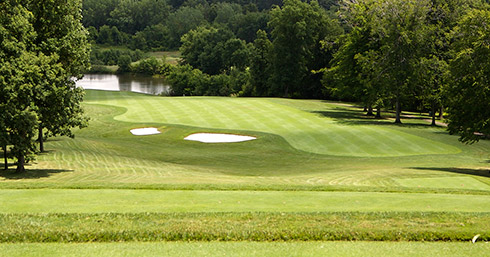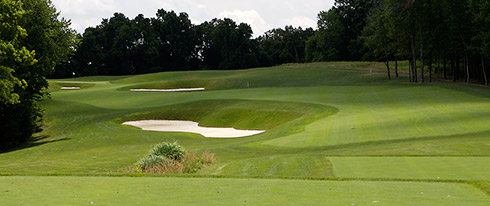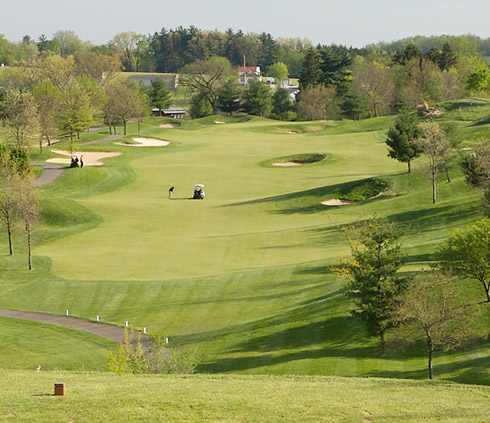 Have you ever been enjoying a round on a new course when suddenly the architect throws a twist at you that just seems out of character? When I’m playing a course laid out by a farmer (there are quite a few of these in central Ohio, by the way), I expect some quirks and tricks, but when a “name” architect does it to me, I can’t help but feel a little betrayed.
Have you ever been enjoying a round on a new course when suddenly the architect throws a twist at you that just seems out of character? When I’m playing a course laid out by a farmer (there are quite a few of these in central Ohio, by the way), I expect some quirks and tricks, but when a “name” architect does it to me, I can’t help but feel a little betrayed.
There are so many challenges designers can build into any course – chutes of trees that threaten drives from both sides, watery graves for errant shots, curled-lip bunkers that throw shots back like Hawaiian waves spit out surfers, murderous contours on firm greens – I don’t understand why architects feel the need to use cheap tricks.What’s the difference between a cheap trick and a good strategic feature? Sometimes, it’s very subtle, like a break that follows the larger slope of the hillside that a green sits on rather than the green contours that might appear destined to make the ball break the opposite direction. That’s a nice touch. It’s difficult to pull off well, and can still be read correctly by an observant player. A cheap trick is usually more heavy handed, like the blind par three on a nearby nine-holer where you have to look into a mirror mounted high on a telephone pole to see the green.
Still, that’s (I hope) a unique touch. It’s not a good hole, but it is memorable in its own cheap way. What really gets my goat are those tricks that various architects, and sometimes superintendants, use all over the place, unfortunately. You’ll probably recognize these annoyances from a course near you.
Number Five: Like Shooting in the Dark
On hilly courses you sometimes can’t avoid them, but blind landing areas can slow down play or be downright dangerous. When you’re playing an unfamiliar course, you have to expect to occasionally have some uncertainty about where to aim your tee shot, but with blind landing areas sometimes you have no idea where aim. And there could be trouble if there are players from the group ahead hidden down there (particularly if they’ve suddenly slowed down because of a lost ball or a visit from the beer cart).
 An optimum view from the 4th tee at Longaberger. Architects should “just say no” to blind shots.
An optimum view from the 4th tee at Longaberger. Architects should “just say no” to blind shots.
There’s a semi-private course in my area with two blind greens on par fives. Now a group of good players can make up a lot of time on a group of high handicappers on a par five. Imagine a group of single-digit handicappers hitting good drives and then going for the green in two. The group ahead could have been playing their third shots when the second group teed off and still be on the green, unseen, when the single digits play their second shots to the green.
Blind shots don’t always annoy me. A notable exception would be the Road Hole at the Old Course. I haven’t played it (yet), but thanks to televison and EA Sports, most of us (or at least many of us) would know what part of the hotel to hit it over to find the fairway beyond, even without a caddy’s help.
It’s not fair, but basically it’s OK when a venerable old layout has a blind shot, because that adds “character.” When an upstart public course features a blind shot, it is often simply trickery. The architect tries to make the player feel uneasy about a shot by hiding the target. It’s a pretty cheap trick.
Some courses make blind landing areas and greens more player-friendly and safe by employing one of a couple solutions. First, there’s the old standby: a well placed bell for each group to ring as they clear the area. Tobacco Road uses a couple of them to make its Disneyland contours a little safer. The second way courses can make a blind area safer is to use one of the built-in GPS systems in their carts that show the positions of other carts around you. It’s a very good system for hilly courses.
Number Four: If It’s Public, Let Joe Hack Play
Few course tricks can slow down the pace of play and utterly deflate high handicappers like a long forced carry. Or several. On one hole. Granted, if you put water or another hazard right in front of a tee, players will find a way to get in there – even good players on occasion – no matter how short the carry. But if you’re asking high handicappers to carry anything approaching 100 yards from the shortest tees, things are going to slow down there on any busy day.
There’s nothing worse than moving along nicely through a busy weekend round only to come to a tee with two groups waiting while a third plays approaches to the green, hitting four because all of them splashed in the hazard. Then the next group tees off and three of them hit the hazard. It can eventually slow down play on all the holes leading up to that point.
The solution is simple. Give the forward tees a bailout. Either let them go around the hazard or give them a short carry to a runout area. People playing the proper tees should not be unnecessarily penalized because they cannot carry the ball far in the air. Some carry is OK, but it should be tailored to the course’s clientele. Architects can always take out there frustrations on the guys playing the tips. Go ahead and make them carry it 200 with no bailout, but give the short knockers a break so everyone can keep moving.
Number Three: What You Can’t See Can Hurt
Several years ago I was playing a course for the first time. I hit what, at the time, was probably among my great drives to date… dead straight and long. When I went up to find the ball, I found that a small creek crossed the fairway, hidden by a small slope in the fairway. I found out later, you can see it from the tee, but only at the very periphery of the hole. If you didn’t know to look, you’d never see it. So there I was, after what I felt was a great drive, hitting three behind the hazard.

The third at Longaberger has plenty of trouble, but you can see it all. “Show me the trouble!” says Cuba Gooding.
Hiding a water hazard, or even a bunker, is a pretty cheap trick on the part of course architects, especially on a public course. On a private course, players know the layout. There’s seldom a foursome that doesn’t have at least one player who’s played the course dozens of times. Public courses with hidden hazards should include GPS or yardage books in their rack rate, or, at the very least, a well-illustrated scorecard and/or a plaque on every tee that clearly shows hazards on the hole.
If you ask me, the first three items on this list are small potatos compared to the last two. These things really annoy me, because if you see them once, you usually see them many times in the course of a round.
Number Two: A Plea for the Bump and Run
When the architect has designed a course with a nice grass corridor leading right up to the green, why do superintendents insist on making these areas so soft that balls landing there just die. It’s clear the area is meant to allow players to take the low road. Do greenskeepers really need to put that much water on the green that the apron in front is saturated all day?
I see this on a lot of new courses (and in Myrtle Beach for some reason), where the drainage should be new and working properly. You’d think they could keep the run-up nice and firm AND the green alive at the same time. I’ve seen it done!
Here’s what bothers me about this setup. What you see is not what you get. Say you hit your drive under some trees. Some limbs block you from taking your usual high ball flight to fly the ball onto the green. But you can play a shot that you see the pros play almost weekly. You can punch it under the limbs, land it just short of the green, and run it on. That’s a good, imaginative play, but even though you execute it perfectly the ball plugs in the soft mud in front of the green, and you’re left with a chip instead of a birdie putt. Hey Supes! If your course has run-ups in front of your greens, let us play them like a run-up.
Hole One: Get It Straight
How many times have you been on a tee box and realized that the shape of the box, the tee markers, or both point directly into a water hazard, the woods, or some other equally dark and undesirable part of the course?

Good tees point you in the right direction. Here, the 18th hole at Eagle Sticks.
I’ve heard people complain about this for years, but until I married a woman who plays it never really bothered me that much. I rarely pay attention to where the tees or markers are pointing, but my wife struggles with her alignment and sometimes falls victim to this cheapest of tricks.
Why in the world does this practice persist? It doesn’t work on the majority of players. It’s generally the less-experienced golfers who suffer (like they need the game made any more difficult, anyway). That’s what bothers me the most about misaligned tees. It generally preys on on those who are having trouble enough just making contact. Forward tees are notorious for being misaligned on many courses.
Now occasionally, the markers get misaligned because a golfer trips over the marker and fails to replace it in the right location. I’ve seen it happen more than once. But usually, it’s the mower guys who move the markers to mow the tees then put them back askew. The supes need to encourage these guys to line up the tees correctly. After all, if you disillusion new players, just who is going to be playing the course when the rest of us get too old to swing?
On some holes though, it’s the whole tee area that lines up at a nice swamp. In those cases, you just have to wonder what the heck the architect was thinking about. Is that really the best he could come up with?
Photo Credits: © The Sand Trap .com.

How bout on a par 4 around 420 yards, having a bunker 75 yards from the green. A decent player will have absolutely no trouble with it, but it will give the high handicapper fits.
The one I hate the most is when course designers either don’t have the room they want for a hard hole or think it is a neat idea and give you a 360 yard par 4 that you have to hit 7 or 8-iron off the tee then turns 90 degrees and you have 210 into the hole. Its like they don’t have the room to make a long par 4 that requires a good drive with the big stick or even a long iron and then you have 190-220 into the hole depending on club choice. I think if its a 90 degree turn at least let me hit a similar or shorter club on the second shot rather than the first.
That depends on how far off the tee the bunker is and whether it carries across the entire corridor of play. In general, if such a bunker completely crosses the play corridor, it would be a problem for high handicappers. However, I don’t think we need to necessarirly remove the “hard” parts of holes. My point about helping high handicappers was more about not killing them off the tee. It’s possible for a routing to give a high-capper a way around a hazard while still making it penal for a low-capper. It’s all about where the typical drives would land (and giving hackers a way around the ugliest stuff). And I think that should be a public course standard, not a private course one (when you join, you accept the course.)
I suspect your first theory is the more usual. And I agree. Nothing results in a more mediocre hole on average than a forced dogleg 350 yard space. I’ve seen several of these and few turn out well. Short par fours require more planning not less for the designers, and when the opposite occurs the players suffer.
The short par 4 dogleg holes can be well done though. Out in LA I play a nice public course called De Bell that’s up in the hills above Burbank, and you pretty much have to put the driver away for the whole middle 2/3’s of the course if you’re like me, a 12-13 handicapper whose good days with the driver means 260-280 and no unwanted shape. But if you’re a low handicapper with great shot control and shaping ability, then you can drive or 3 wood most of the par fours.
My personal favorite: the public course that is too difficult for “normal” golfers to play. For example, one local course has a hole that is an abomination for the average golfer.
Because the hole is built around a hill, the fairway slopes from right to left. A good drive is to the right side of the fairway leaving you a lie in the left side of the fairway, but you will almost always have the ball above your feet. Because they were too stupid/lazy to cut a large tree down, the approach shot must be a fade.
How many average golfers do you know who can hit a fade from a hook lie? BTW – if you miss your approach left, you roll down the hill into a ravine.
My worst experience on a golf course was the perfect storm of several of these kinds of tricks. The hole was a shortish par 5 with 120 yard carry over water in front of the green. The bad part was that there was a 50 yard slope down to the water, so you had a long carry off a downhill lie. Waiting on the other side of the water was a green that sloped no less than 8 feet from back to front.
I stopped counting at 16. 😡